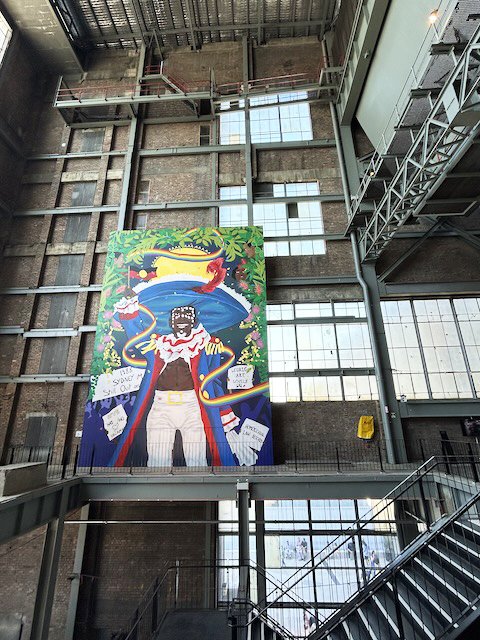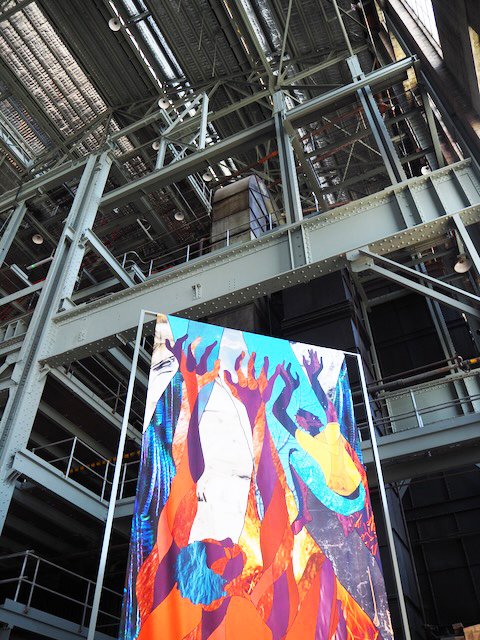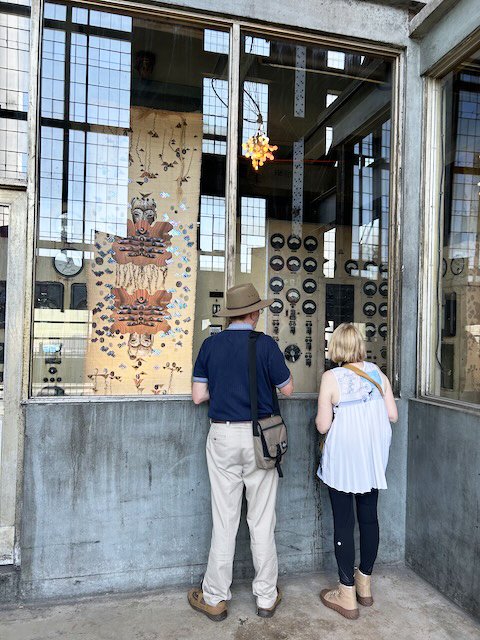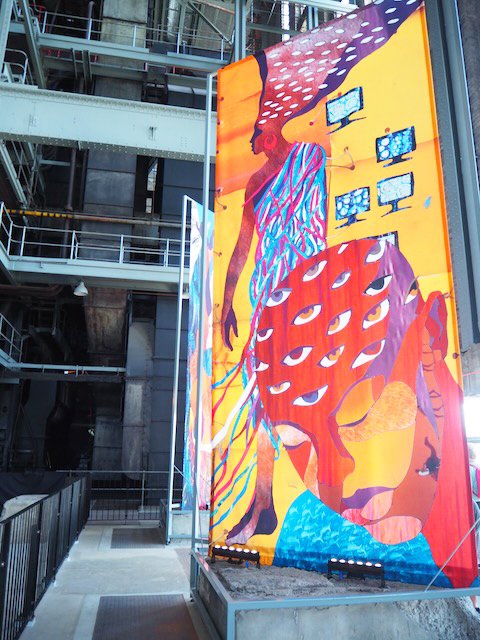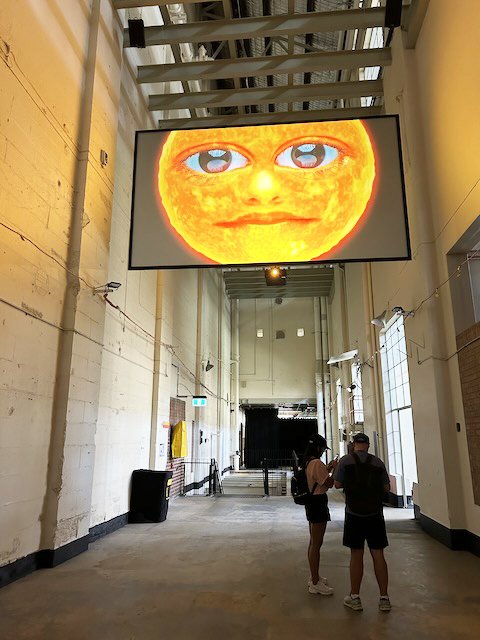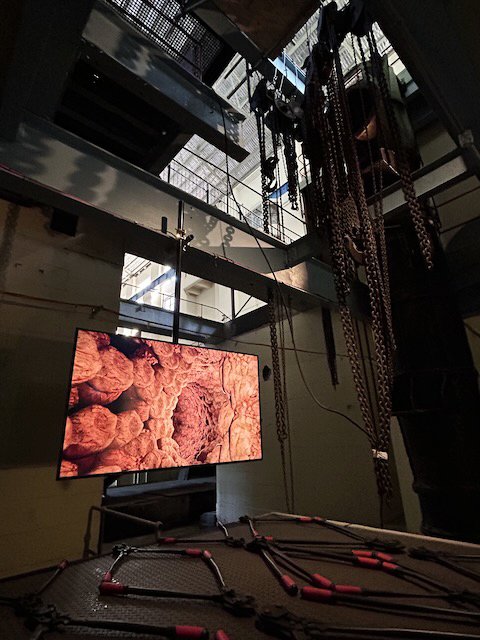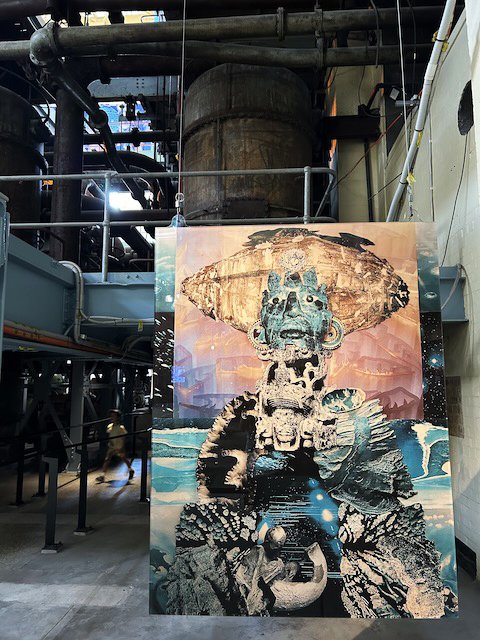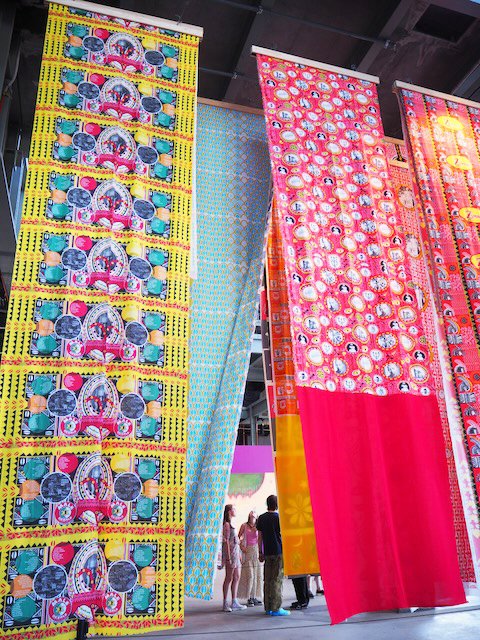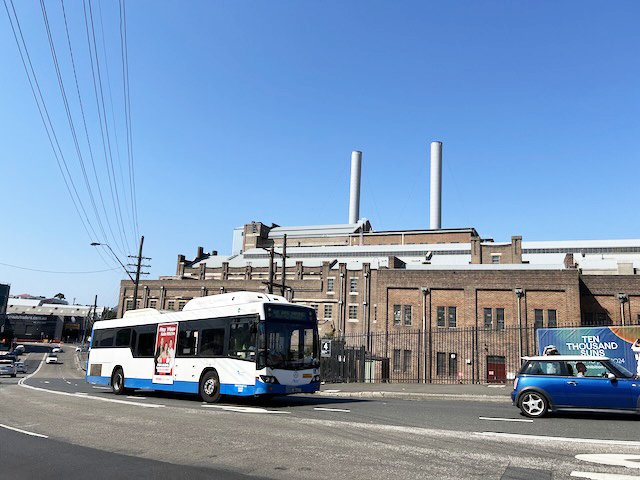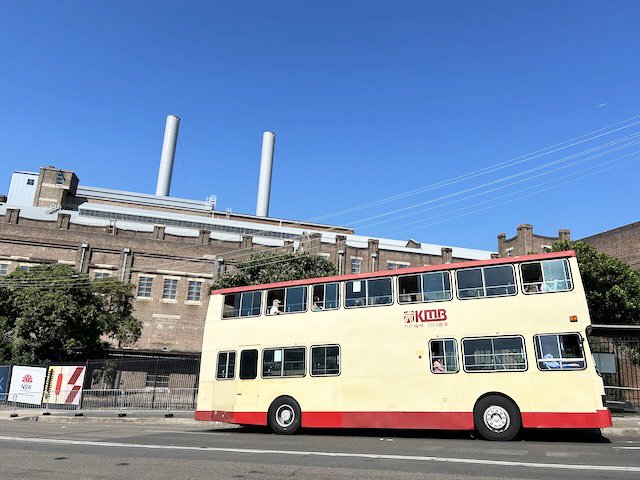Biennale of Sydney 2024 at White Bay Power Station - Review
The 24th Biennale of Sydney, titled Ten Thousand Suns is on this year across 6 iconic Sydney locations including the Sydney Opera House where its sails will have projections of first nations stories during the Biennale daily from sunset to nightfall. I visited one of the sites last weekend solo (as the kids were under the weather) which is a real shame as I had such a great experience! But I visited the site with kids in mind and it is definitely kid and family friendly and saw lots of families enjoying themselves. The Biennale of Sydney 2024’s theme is that of celebration, Mardi Gras and discussion of current social issues. On now until 10th June 2024!
I can’t talk about the Biennale of Sydney without talking about this impressive White Bay Power Station building inside and out! The building was built over 5 years from 1912 to 1917 to power the tram system and later rail networks. It provided power to the electricity grid after 1958 and remained in service until it was decommissioned in 1984. Following extensive remediation works and $100 million investment from the NSW Government, the restored heritage site has been transformed into a unique art, cultural and creative industries hub and perfect for the Biennale of Sydney! This is the first time in 40 year since it was decommissioned and left derelict that the White Bay Power Station has been open to the public! The building and the art are so fitting, a true marriage of old & new where art, architecture and history meet!
Photo credit: @busycitykids
I had the luxury of time on this visit, so I joined one of the Art Tours taking place on the day. The first one was at 11:15am (15 minutes after opening), it was sold out however I was told to wait and see if any cancellations would come through to grab a ticket and I did (more info re tickets and how to book in our tips below). I found out during the tour, there is a Building Tour which I might contemplate for another visit. Our Art Tour guide was very knowledgeable about the building, the arts on display and art history in general.
During the tour, we covered around 11 major pieces. First up (shown photo below) is one of Doreen Chapman’s work and is exhibiting 2 pieces at White Bay and other pieces across all sites of the Biennale of Sydney this year (the only artist to) so keep a lookout for them! Doreen Chapman, a Manyjilyjarra artist is deaf and considers painting, a crucial medium of communication and storytelling. The piece below represents ATM machines in rural indigenous communities and how money is shared amongst community members.
Doreen Chapman - Untitled, 2023 - Photo credit: @busycitykids
Next up (photo on left below), Eric–Paul Riege’s piece which is a representation of jewellery and a link to the gods. It towers 3 floors and represents oversized sheep intestine. Eric–Paul Riege is a Diné weaver and fibre artist which has a deep connection with his family of weavers. He feels that he is an extension of his artwork when weaving and performed welcoming rituals at the two sites where he is exhibiting during the Biennale.
The third piece (photo on right below) is that of Cristina Flores Pescorán, a multi-disciplinary artist from Peru. After her skin cancer diagnosis, Cristina weaved as part of her healing process. Her pieces are material-lead meaning while she does weave a shape in some way, the material stretches and takes a different form once hung. She uses natural material and material which is dyed before hanging. In this piece she used purple corn for the purple dye colour in the material.
Eric–Paul Riege - Photo credit: @busycitykids
Cristina Flores Pescorán - Abrazar el sol - Photo credit: @busycitykids
Cristina Flores Pescorán’s piece Abrazar el sol (Embrace the Sun) is my favourite piece of the Biennale this year and it definitely caught the sun and light on the day. It is such a beautiful piece to admire from all angles and from above and below and throughout the building!
Cristina Flores Pescorán - Abrazar el sol - Photo credit: @busycitykids
The next two pieces spoken about during the tour, were in the same space and are of Darrell Sibosado Bard and the Aumoana Group. Darrell Sibosado Bard is Bard man from Lombadina and his LED light installation (on right side of the wall photo below) Galalan at Gumiri amplifies the luminescence of riji designs and traditionally carved oyster shells. The building is illuminated by this piece as a rebirth of the space and White Bay Power station. The Aumoana Group’s works were hung from above and represented kites of all different stories. The collective made the cloth hand-crafted from the bark of paper-mulberry tree, painted them and turned some into beautiful kites you can see shown below.
Darrell Sibosado Bard and Aumoana Group - Photo credit: @busycitykids
Lawrence Lek’s Nepenthe piece was very interesting and showed a surreal look into the old Summer Palace ruins and showing us what it was like in a game-like way. I lived in China for a number of years and never heard of this beautiful palace outside of Beijing. The tour guide explained that it was looted by French and English armies during the second Opium war and that millions of precious art and artefacts were taken from the palace and are now located across Europe. A Pekingese dog acquired during the looting was offered to Queen Victoria which she named Lootie/Looty after its looting acquisition. Kids and adults might be able to see Looty in the game (shown right photo below) which is located next to the Nepenthe gate.
Lawrence Lek’s - Nepenthe - Photo credit: @busycitykids
Photo credit: @busycitykids
The next pieces (shown in background of image below), are by VNS Matrix, an Australian feminist art collective which emerged in 1991 to challenge the male-dominated culture of technology and cyberspace which still resonates today. Their pieces discuss a connection between the body and the internet and gender. Some images of nudity are depicted on the other side of the posters shown below. There is also explicit images and content and posters shown in a room on the right side of the building close to the major pieces so caution is advised with young children around.
Photo credit: @busycitykids
Another favourite piece part of the tour was the large nine-by-three-metre skeleton video piece by Özgür Kar. This skeleton video moves and comes alive every 30 minutes which is a beautiful resonance across the building when it sounds. It depicts a skeleton trying to sound the alarm to the world using his french horn and is a reflection of the current societal struggles, the cost of living crisis, current wars across the world and the dread that social media brings to people’s lives with its distraction which is depicted by the birds.
The other piece (pictured right below), is of Monira Al Qadiri, a Kuwaiti visual artist born in Senegal and educated in Japan. The video depicts the beauty of the petro-culture in the Gulf with a representation of this oil refinery with its god-like inhabitants. The video beautifully narrated by her sister is a must see and you’ll wonder if if it’s real or not (I won’t spoil it).
Özgür Kar - Photo credit: @busycitykids
Monira Al Qadiri - Photo credit: @busycitykids
Last but not least is the large piece which takes centre stage at the White Bay Power Station which was especially commissioned for the Biennale of Sydney this year is Dylan Mooney’s large mural painting of Malcolm Cole. Dylan Mooney is a proud Yuwi, Torres Strait and South Sea Islander man who is low vision impaired thus legally blind. Mooney memorialised through his mural, a photo of Malcolm Cole who was a pre-eminent innovator of contemporary dance who conceived the 1988 Indigenous float at the Sydney Gay & Lesbian Mardi Gras with artist Panos Couros. Sentiments echoed by Mooney, himself a queer Indigenous artist who reclaims the rainbow flags representative of both the story of the Rainbow Serpent in dreamtime stories and the endurance of queen Indigenous people.
Dylan Mooney - Malcom Cole - Photo credit: @busycitykids
The last pieces were of Guatemalan first all-female group of kite makers called Orquídeas Barrileteras, made up of 22 members and spanning 3 generations. Hand-made from cloth, paper, bamboo, tissue, string, and natural materials and flown to honour the dead they share familial stories, cultural themes and many emotions through pattern and bright colours. This is the first time these kites have left their country of origin and shipped across the world due to their delicate nature. They were reinforced by metal elements to hold in the space. Such beautiful kites!
Photo credit: @busycitykids
I really enjoyed the Art Tour which was well worth the time and small cost. Some families joined us but due to the nature of the duration of the tour (around 1 hour) and some detailed explanation, some families left the tour as the children tuned out a bit so be conscious if you are booking a tour with young children.
This completes the artworks I experienced on the Art Tour however there are so many other great works at this year’s Biennale of Sydney, so many I can’t cover and so many I photographed but won’t make this blog post sadly!
Pictured below (left photo) is the impressive The Beast of Jade Mountain mask by Andrew Thomas Huang. In ancient Chinese myth, five tigers hold powers. In Chinese Zodiac sign, the tiger symbolises nobility and fearlessness. Andrew Thomas Huang understands queerness as the transgression of boundaries, the tiger is a symbol of liberation.
Andrew Thomas Huang - Photo credit: @busycitykids
Photo credit: @busycitykids
Other works to note is Mangala Bai Maravi’s Baiga Godna Indian Tribe, 2024 piece with another piece exhibited at Chau Chak Wing Museum at the University of Sydney. Mangala Bai Maravi is committed to preserving customs of the Baiga people whose women in these communities can receive tattoos from the age of 9 starting with their forehead before covering their back, legs and chest. The Godna design is a record of life and culture and holds remedying when applied correctly, very interesting and symbolic!
Mangala Bai Maravi - Photo credit: @busycitykids
The White Bay Power Station is very large so allow a couple of hours to see all the art and all the wonders of this interesting building. I will do a seperate post on the building alone however you can see from the photos in this blog post that this is a remarkable building!
Photo credit: @busycitykids
I really enjoyed how the curators mixed the elements of the building and included art throughout even behind glass where power used to be controlled from.
Photo credit: @busycitykids
Photo credit: @busycitykids
Overall an impressive Biennale with Cockatoo Island vibes (we loved the 2018 Biennale, see review here) and some impressive artwork on exhibition in this historical and tall building. I loved the grandeur of this building especially for the large pieces on display and the material pieces flowing with the wind.
Another great piece I quite enjoyed by Kaylene Whiskey (below left) was Kaylene TV, 2023. Visitors can walk around the life-size cut-outs of pop cultural icons like singers Cher and Dolly Parton and also walk inside the tv (from the right side of the tv) and experience Kaylene’s tv and posters of Whitney Houston and music and you can hear her talk. Checkout the cool ceiling too! This piece can be seen from the outside of the building with a heart shaped Aboriginal flag on its side.
Kaylene Whiskey - Photo credit: @busycitykids
Photo credit: @busycitykids
I really enjoyed the Biennale of Sydney at White Bay Power Station this year made even more special in this incredible building!
Photo credit: @busycitykids
While I was at White Bay Power Station and waiting for my bus to Balmain Wharf, I noticed lots of public transport on offer so make sure you take advantage of the frequent buses to the QVB City or in the other direction. You can also hop on vintage buses courtesy of the Bus Museum which we loved visiting one year (our review here)! The entrance to White Bay Power Station is along the building, if you arrive on the opposite side of the road where the building is, head to the lights to cross and walk along the building fence and barricades until you see a big black gate with number 3. There is heavy traffic on this road so be careful and use the crossing provided or ask the transport staff on hand if you are not sure.
Note: Art tour and transport was self-funded.
Our tips:
White Bay Power Station is located at 28 Robert St, Rozelle NSW 2039.
Opening hours are 11 am to 6 pm every day - closed Mondays.
Entry is FREE.
Art tours start at 11:15 am and get sold out easily but do check with kiosk for spare tickets as some last minute cancellations might mean you can grab a last minute ticket. Adult $10 and Concession $5. There is also a building tour, enquire with kiosk for more info. Book Art Tours online here. Auslan Tours also available.
Sensory friendly sessions on Tuesday mornings from 11 am to 1 pm at White Bay Power Station.
White Bay Power Station is accessible with ramps and a brand new lift for prams and wheelchairs.
White Bay Power Station is a remediated space. Please be mindful of uneven ground, low clearances and unfinished surfaces. Please do not enter areas that are restricted.
No pets allowed onsite, service animals are welcome.
Toilets are located at the back of the building, follow signage.
There is a café with food & drinks in the middle of the bottom floor and lots of seating inside and outside at the back of the building including seating at the front of the building too.
This exhibition includes explicit content such as images and text that may be confronting, including stylised images of genitalia and coarse language. Some artworks will feature strobe lighting in this exhibition.
Limited parking available in the area but plenty of public transport running very frequently to & from White Bay Power Station, more info here.


















